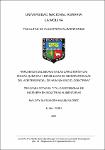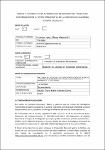Mostrar el registro sencillo del ítem
Influencia del secado en las características físicas, químicas y estabilidad de micropartículas del aceite esencial de naranja en ciclodextrina
| dc.contributor.advisor | Nolazco Cama, Diana Maria | |
| dc.contributor.advisor | Villanueva Quejía, Elizabeth Milagros | |
| dc.contributor.author | Huaman Lopez, Malory Alessandra | |
| dc.date.accessioned | 2023-05-02T20:24:15Z | |
| dc.date.available | 2023-05-02T20:24:15Z | |
| dc.date.issued | 2023 | |
| dc.identifier.uri | https://hdl.handle.net/20.500.12996/5774 | |
| dc.description | Universidad Nacional Agraria La Molina. Facultad de Industrias Alimentarias. Departamento Académico de Tecnología de Alimentos y Productos Agropecuarios | es_PE |
| dc.description.abstract | El presente trabajo se centró en determinar las diferencias entre los métodos de secado aplicado al aceite esencial de naranja encapsulado en beta-ciclodextrina (β-CD) mediante la técnica de inclusion molecular. En primer lugar, se caracterizó el aceite esencial de naranja adquirido mediante densidad e índice de refracción y posteriormente, se procedió a microencapsularlo. Para la formación de los microencapsulados, inicialmente se disolvió βCD en agua destilada en 6.9 por ciento (m/v) a 50°C, luego se enfrió hasta 35°C y se añadió aceite esencial gota a gota en relación peso/peso de 1:8.33 (ambos en g) de aceite/βciclodextrina con agitación constante a 900 rpm por 3 h y 30 min. Posterior a ello, se refrigeró por 16 h a 4°C, luego de dicho tiempo, la solución obtenida se centrifugó a 3500 rpm por 10 min y se decantó. Finalmente, se secó mediante estufa a 50°C por 24 h, liofilizado a -40°C a presión absoluta de 13.33 Pa por 17 h y atomizado a 160, 180 y 200°C con una boquilla de 1 mm a un flujo de 3.35 ml/min, obteniéndose 5 tratamientos con 3 repeticiones cada uno. Todas las muestras fueron caracterizadas respecto a su humedad, higroscopicidad, actividad de agua, eficiencia y rendimiento, microestructura y espectros FT-IR, además, se realizó una evaluación de su estabilidad almacenándolas a 20°C con 82 por ciento de humedad relativa por 36 días. Los resultados mostraron diferencias significativas (p<0.05) entre los tratamientos para la eficiencia, humedad, higroscopicidad y actividad de agua; asimismo, las microestructuras mostraron diferencias en su morfología entre muestras las atomizadas y las liofilizadas. Los resultados del FT-IR de los encapsulados mostraron formación de nuevos enlaces entre el aceite esencial de naranja y la beta-ciclodextrina y, en algunos casos una pérdida de estas uniones, lo cual sería causado por efecto de la temperatura. Finalmente, a través del tiempo de almacenamiento, todos los tratamientos mostraron tendencia a perder su eficiencia y aumentar su humedad y actividad de agua. Se determinó que la mayor eficiencia la presentó el método de secado por liofilización con un promedio de 97 por ciento, además de presentar las mejores propiedades al inicio y término de la evaluación de estabilidad. | es_PE |
| dc.description.abstract | The present work focused on determining the differences between drying methods applied to encapsulated orange essential oil in beta-cyclodextrin (β-CD) formed by molecular inclusion. First, the orange essential oil acquired by density and refractive index was characterized and subsequently, it was microencapsulated. For the formation of the microencapsulates, β-CD was initially dissolved in distilled water in 6.92 percent (m/v) at 50°C, then cooled to 35°C and essential oil was added drop by drop in weight/weight ratio of 1:8.33 (both in g) of oil / β-cyclodextrin with constant stirring at 900 rpm for 3 h and 30 min. After that, it was refrigerated for 16 h at 4°C, after that time, the solution obtained was centrifuged at 3500 rpm for 10 min and decanted. Finally, it was dried by oven at 50°C for 24 h, lyophilized at -40°C at an absolute pressure of 13.33 Pa for 17 h and atomized at 160, 180 and 200°C, with a 1 mm nozzle at a flow of 3.35 ml/min, obtaining 5 treatments with 3 repetitions each. All samples were characterized with respect to their humidity, hygroscopicity, water activity, efficiency and yield, microstructure and FT-IR spectra, in addition, an evaluation of their stability was carried out by storing them at 20 ° C with 82 percent relative humidity for 36 days. The results showed significant differences (p<0.05) between the treatments for efficiency, humidity, hygroscopicity and water activity. Likewise, the microstructures showed differences in their morphology between atomized and lyophilized samples. The results of the FT-IR for the encapsulated showed formation of new bonds between the essential oil of orange and beta-cyclodextrin and, in some cases a loss of these bonds, which would be caused by the effect of temperature. Finally, throughout the storage time, all treatments showed tendency to lose their efficiency and increase their humidity and water activity. It was determined that the highest efficiency was presented by the lyophilization drying method with an average of 97 percent, in addition to presenting the best properties at the beginning and end of the stability evaluation. | es_PE |
| dc.format | application/pdf | es_PE |
| dc.language.iso | spa | es_PE |
| dc.publisher | Universidad Nacional Agraria La Molina | es_PE |
| dc.rights | info:eu-repo/semantics/embargoedAccess | es_PE |
| dc.rights.uri | https://creativecommons.org/licenses/by-nc-sa/4.0/ | es_PE |
| dc.subject | Inclusión molecular | es_PE |
| dc.title | Influencia del secado en las características físicas, químicas y estabilidad de micropartículas del aceite esencial de naranja en ciclodextrina | es_PE |
| dc.type | info:eu-repo/semantics/bachelorThesis | es_PE |
| thesis.degree.discipline | Industrias Alimentarias | es_PE |
| thesis.degree.grantor | Universidad Nacional Agraria La Molina. Facultad de Industrias Alimentarias | es_PE |
| thesis.degree.name | Ingeniero en Industrias Alimentarias | es_PE |
| dc.subject.ocde | Pendiente | es_PE |
| renati.author.dni | 71842639 | es_PE |
| dc.publisher.country | PE | es_PE |
| dc.type.version | info:eu-repo/semantics/publishedVersion | es_PE |
| dc.date.embargoEnd | 2024-12-15 | es_PE |
| renati.advisor.orcid | https://orcid.org/0000-0002-8192-7611 | es_PE |
| renati.advisor.orcid | https://orcid.org/0000-0002-9609-5379 | es_PE |
| renati.advisor.dni | 40960143 | es_PE |
| renati.advisor.dni | 42336137 | es_PE |
| renati.type | https://purl.org/pe-repo/renati/type#tesis | es_PE |
| renati.level | https://purl.org/pe-repo/renati/level#tituloProfesional | es_PE |
| renati.discipline | 721026 | es_PE |
| renati.juror | Hatta Sakoda, Beatriz Alma | |
| renati.juror | Vargas Delgado, Luis Fernando | |
| renati.juror | Baldeón Chamorro, Edwin Orlando |
Ficheros en el ítem
Este ítem aparece en la(s) siguiente(s) colección(ones)
-
IAL-TA Tesis [112]





